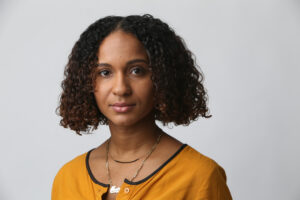NAHJ falls short on inclusivity for Afro-Latino journalists, members say. Some want change.
LOS ANGELES — Two months ago, Boris Q’va decided to do something he’s never done before: Speak out about the issues facing Black Latinos to his peers in a panel put on by the National Association of Hispanic Journalists.
He had prepared his thoughts and written three main points down on a notepad that he kept by his side.
But when the time came and the panel began, he looked up, expecting to see a Zoom full of faces. Instead, only six people were there.

“I understand that people have stuff to do, and some organizational improvements need to be done in these online events, but it’s impossible to understand that for such an important topic being discussed in the United States, our Latino community decides not to attend and talk about it,” Q’va said of the panel “Challenges of Afro-Latinxs Journalism Students in the US.”
Q’va is a student journalist and a member of NAHJ and the National Association of Black Journalists. He is among a number of Latino journalists who have begun to speak out about the challenges of being Black and Latino in an organization — and an industry — that often does not acknowledge their experiences.
A year after the police killing of George Floyd in Minneapolis, which sparked months of protests and difficult conversations about racism and inequality, those conversations continue to affect newsrooms and news programming around the country. For Afro-Latinos in the journalism industry, the lack of support within the broader Latino community is a problem that leaves many dark-skinned Latinos feeling left out and unrepresented in mass media and the newsrooms that produce it.
Afro-Latinos make up almost 25 percent of the Latino population, according to a study by the Pew Research Center. In journalism, Afro-Latinos comprise a small portion of an already underrepresented group.
According to 2021 membership data kept by the organization, less than 1.5% of NAHJ members identify as Afro-Latino — just 58 out of 4,061 members as of late June.
NAHJ has been criticized over the past year for its lack of representation and inclusion of Afro-Latino journalists, an issue that has for years plagued the industry at large. The journalism organization included several sessions in its annual conference to address issues of race in the Latino community.
NAHJ leaders “agree it’s necessary to do more when it comes about Afro-Latino representation,” NAHJ President Nora López said in an interview with the Latino Reporter on Wednesday, a day after this story was initially published.
Some journalists, like Cristina Silva, an editor at USA Today, have taken to social media to air their grievances against the organization.
“I am grateful for the leadership of NABJ, which has often lead the way [sic],” she tweeted on the first day of the NAHJ conference this week. “But it's long overdue for NAHJ to do more to fight anti-Black racism and stand with NABJ.”
Silva declined to comment to the Latino Reporter for this story.
Keldy Ortiz, who identifies as Dominican American and serves as the NAHJ board's financial officer, said the Latino community is diverse and comprises many races, colors, ethnicities, backgrounds and challenges. But the news media often flatten its culture into one singular experience.
“We can see on media how Latinos are particularly portrayed as whiter-colored Latinos as if they were the majority when we have various colors of Latinos,” Ortiz said, adding that “we just need to let the public know that there are different colors and shapes of Latinos.”
Q’va — who is a member of both the largest associations of Black- and Latino-identifying journalists in the country — said he has found that NABJ shows more support in centering Afro-Latino experiences than NAHJ does.
“We need a real change. I am not talking of just placing an Afro-Latino in a leadership role,” Q’va said. “I am talking about putting an effort to prepare Afro-Latino journalism students to become part of the organization’s discussion. We need to put the time in to educate our members and break the barrier of a monolithic community.”
For Q’va, the problem is bigger than NAHJ — it exists within the Latino community at large. He explained how stereotypes and racial profiling make it challenging for some non-Black Latinos to accept that the Latino community is made up of a diverse group.
“The Latinos, we are always fighting against being profiled by the government, but how are we doing so when we are profiling our brothers and sisters within our community?” Q’va said. “We need to be at the front of this conversation because we are the ones representing our community in the news.”
Issues of colorism and the exclusion of Afro-Latinos came to a head earlier this year with the release of Lin Manuel Miranda’s In the Heights movie, which many Afro-Latino journalists and film critics accused of excluding dark-skinned actors while portraying the largely Dominican neighborhood of Washington Heights in New York.
In the Heights, the film version of the Broadway musical, premiered in theaters and online June 9. Many Latinos, including prominent members of the press, heralded the movie as an essential step forward in the film industry for Latino representation and storytelling.
But many others criticized the movie, Miranda, and others involved with the project for what seemed to be a critical oversight.

Concepción de León is a reporter for the New York Times and has been vocal about colorism, discrimination and the impact of erasing Afro-Latinos from the picture.
“At this point, you want to move forward in the right way,” said de León, who is Afro-Latina. “This idea of just waiting your turn is so tiring.”
The film In the Heights, she said, was given an impossible task: to represent a community that is diverse and difficult to define.
“The casting was a big problem,” de León said. “I am over these movies that are generally about Latinos; we are such a diverse community, not just in complexion but culturally, there are so many cultural differences.”
De León said instead of portraying the Latino community as one monolith, creators miss an opportunity to tell more interesting and accurate stories by not zeroing in on the many subgroups that each bring their own nuances to Latinidad.
“I think it’s time to move several steps further,” de León explained. “I think these movies always present this monolithic community, like this dancing and laughing community, which we are, but it is not all of who we are. I think this movie is a miss of opportunity, and it did not do what it could to further the narrative about specific Latino subgroups.”
As these conversations continue online, NAHJ has attempted to bring them into the real world by offering several panels about racism, diversity and inclusion in the programming of the NAHJ 2021 conference.
Among the conference’s offerings are sessions called “Addressing anti-Blackness & anti-Indigenous racism in the Latinx community,” and “A liberated future through Afrofuturism & Chicanafuturism.”
Ortiz encouraged members to think of other ways to make the organization more inclusive and educated.

“I would love to hear what opportunities could be created,” Ortiz said. “Yes, we can talk about it, but it’s about how we push things forward.”
Janete Weinstein, who runs her own Los Angeles news channel, BDCi TV, which caters to the Brazilian community, said diverse organizations are better equipped to cover and represent diverse communities.
“When I started working 15 years ago, I did not see people of my skin color in the newsroom,” said Weinstein, who is Brazilian and of African, indigenous and Portuguese descent. “Depending on whom I was working with, I did not receive important stories to cover.”
Ortiz said he would like to see more Afro-Latino members take on leadership roles in the organization.
“First of all, we need to identify who are those Afro-Latino members, how NAHJ can help them, and how can these members help our organization,” Ortiz said. “This should have been a conversation we had a long time ago.”
Editor's note: This story has been updated to include comment from NAHJ President Nora López.
CLARIFICATION: This story has been updated to more accurately reflect the scope of criticism leveled against NAHJ.
Jorge Flores is a junior at California State University, Fullerton, where he studies political science and journalism. He is an intern at NBC Telemundo Enterprises and was recently elected president of the NAHJ student chapter at his school. Reach him at jorgeflores.fs [at] gmail [dot] com and on Twitter @jorgefles.
Excelente reportaje, Jorge. Me sorprendió la composición étnica de los miembros de NAHJ. Yo no estaba al tanto incluso estando en la Junta de Directores.